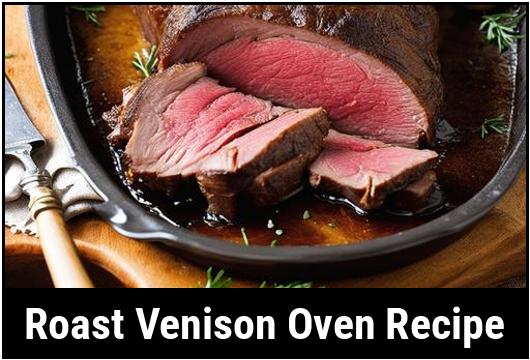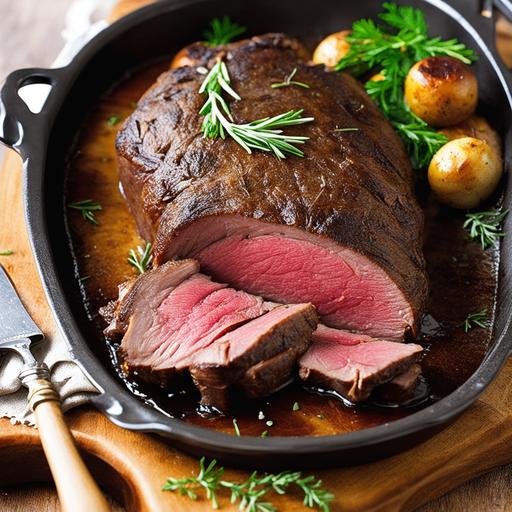
Roast Venison Oven Recipe: A Comprehensive Guide
Venison is one of the most classic and delicious game meats out there. With a lean, tender texture and a distinct, rich flavor, venison is a popular alternative to beef and other red meats, especially during game season. Roasting venison in the oven is one of the best ways to highlight its flavor and texture.
In this article, we will explore everything you need to know about making a perfect roast venison dish in your own oven. From selecting the right cut of meat to cooking it to perfect doneness, we’ll break down each step of the process, giving you all the culinary tips and tricks you need to make this dish a successful one.
The Science of Venison
Before we dive into the recipe, let’s take a moment to explore the science behind venison meat. Venison is derived from deer and other game animals and is known for its nutritional properties, such as high protein and low fat content. Venison meat also contains valuable micronutrients, such as iron, zinc, and B vitamins.
The flavor of venison is often described as "earthy" and "gamey," and its aroma is typically muskier than that of beef. This is due to the presence of myoglobin and iron, which give venison its dark, distinctive color. When cooked, venison tends to be much leaner than beef, which can make it a bit more challenging to prepare. However, proper preparation is key to creating a delicious and tender roast venison dish.
Selecting Venison Meat
When selecting venison meat for your recipe, there are a few factors to keep in mind. Firstly, make sure to choose a cut of meat that is fresh and has been stored properly. Look for meat that is firm and has a deep red or reddish-brown color. Avoid meat that is brown or gray, as this may indicate spoilage.
The cut of meat you choose will also affect the flavor and texture of your roast venison. While there are many cuts of venison available, some of the most popular for roasting include the loin, rump, and shoulder. The loin is the most tender cut and is often the most expensive, while the rump and shoulder are tougher but can be just as flavorful if slow-cooked properly. You may also want to consider the age of the animal the meat came from, as younger venison will be more tender.
Preparing the Meat

Before roasting your venison, it’s important to let it reach room temperature first, which can take anywhere from 30 minutes to an hour. This allows the meat to cook more evenly and prevents it from drying out too quickly. When preparing your meat, you may also want to consider marinating it first, which can add flavor and help tenderize the meat.
Next, you’ll need to season your venison. While venison has a rich flavor of its own, it can be enhanced with the right blend of herbs and spices. At a minimum, use salt and black pepper. Others seasonings to consider include thyme, rosemary, and garlic, which all pair well with venison. Be careful not to overpower the meat with too much seasoning, however, as venison’s flavor can easily be overwhelmed.
Roasting the Venison
After seasoning your venison, it’s time to roast it in the oven. Preheat your oven to 350°F (175°C) and place your seasoned venison on a wire rack in a roasting pan. For best results, insert a meat thermometer into the center of the meat, making sure it does not touch any bones. This will allow you to monitor the temperature and take it out of the oven just as it reaches your desired level of doneness.
Roasting times will vary depending on the cut of meat and the desired level of doneness. As a general rule, aim for a cook time of 15 to 20 minutes per pound of meat. For a medium-rare roast, remove the venison from the oven when it reaches an internal temperature of 130°F (54°C), which should take about 18 to 20 minutes per pound. For a medium to well-done roast, continue cooking until the internal temperature reaches 150°F (66°C) or higher.
Doneness Checks

To ensure your venison is perfectly cooked, you should perform a few checks along the way. First, check the color of the meat – when the venison is cooked to a medium-rare level, it should be dark pink in the center and lighter pink on the edges. If the meat is too red, continue cooking until it gets pinker in the center.
As you approach your desired temperature, you can also perform a touch test. Press the center of the roast with your finger – if it springs back, the meat is still raw. If it is firm but gives slightly, the meat is medium-rare. If the meat is firm and does not give at all, it is well-done.
Overcooking or Undercooking
One of the biggest mistakes when roasting venison is overcooking or undercooking it. Overcooked venison can become dry and tough, while undercooked venison can be unpleasantly chewy and even unsafe to eat. It’s important to monitor the internal temperature of the meat carefully and to only take it out of the oven when it reaches the right level of doneness.
If you accidentally overcook your venison, there are a few things you can do to salvage it. Try slicing it thinly and serving it with a flavorful sauce or gravy, which can help add moisture. Alternatively, wrap the meat in foil and cook it at a low temperature for a short period of time with some broth or other liquid to help restore moisture.
Variations on the Recipe
There are plenty of ways to take your roast venison recipe to the next level. Some popular variations include:
-
Adding a berry sauce or reduction, such as cranberry or blackberry, to complement the rich, gamey flavor of the meat.
-
Incorporating other flavors into the marinade or seasoning, such as juniper berries or red wine.
-
Serving the roast with roasted vegetables or a side salad to balance out the rich flavor of the meat.
Conclusion
Roasting venison in your oven can be a delicious and rewarding experience. By following these culinary tips and tricks, you’ll be able to create a perfectly cooked, tender roast that highlights the unique flavor and texture of venison meat. Whether you’re a seasoned hunter or just looking to try something new, this roast venison recipe will not disappoint.
Sources
FAQS On Roast Venison Oven Recipe
Can I Use Any Cut Of Venison For This Roast Venison Oven Recipe?
Yes, you can use any cut of venison for this recipe. However, it is recommended to use a boneless roast such as the shoulder or loin for the best results. These cuts are tender and well-suited for roasting.
How Do I Prepare The Venison Roast Before Cooking It In The Oven?
Before cooking, it is important to properly marinate the venison roast to enhance its flavor and tenderness. You can create a simple marinade using a combination of olive oil, red wine, garlic, and herbs. Allow the venison to marinate in the refrigerator for at least 4 hours or overnight for optimal results.
What Is The Ideal Cooking Temperature And Time For Roast Venison In The Oven?
The ideal cooking temperature for roast venison in the oven is 350°F (175°C). Cooking time will vary depending on the size and thickness of the roast, but as a general guideline, you can cook a 3-4 pound (1.4-1.8 kg) roast for approximately 20-25 minutes per pound (450-550 grams). It is recommended to use a meat thermometer to ensure the internal temperature reaches 145°F (63°C) for medium-rare or 160°F (71°C) for medium doneness.
How Do I Keep The Roast Venison Moist During Cooking?
To keep the roast venison moist during cooking, you can baste it with the marinade or a mixture of melted butter and herbs every 20-30 minutes. This will help to lock in the moisture and add extra flavor to the meat. Additionally, covering the roast loosely with aluminum foil for the first half of the cooking time also helps to retain moisture.
Should I Let The Roast Venison Rest After Cooking?
Yes, it is recommended to let the roast venison rest for about 10-15 minutes after removing it from the oven. This allows the juices to redistribute within the meat and results in a more tender and flavorful roast. Simply tent the roast loosely with foil and let it rest on a cutting board before slicing and serving.


